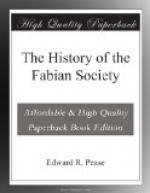But it must be remembered by critics that so far as concerns the Fabian Society, the absence of identity in organisation has never led to such hostility as has been common amongst Continental Socialists. Since the vote of censure in relation to the “Tory Gold,” the Fabian Society has never interfered with the doings of its friendly rivals. The two Societies have occasionally co-operated, but as a rule they have severally carried on their own work, each recognising the value of many of the activities of the other, and on the whole confining mutual criticism within reasonable limits.
The second and chief reason for the success of the Society was its good fortune in attaching to its service a group of young men, then altogether unknown, whose reputation has gradually spread, in two or three cases, all over the world, and who have always been in the main identified with Fabianism. Very rarely in the history of voluntary organisations has a group of such exceptional people come together almost accidentally and worked unitedly together for so many years for the furtherance of the principles in which they believed. Others have assisted according to their abilities and opportunities, but to the Fabian Essayists belongs the credit of creating the Fabian Society.
For several years, and those perhaps the most important in the history of the Society, the period, in fact, of adolescence, the Society was governed by the seven Essayists, and chiefly by four or five of them. Mrs. Besant had made her reputation in other fields, and belonged, in a sense, to an earlier generation; she was unrivalled as an expositor and an agitator, and naturally preferred the work that she did best. William Clarke, also, was just a little of an outsider: he attended committees irregularly, and although he did what he was persuaded to do with remarkable force—he was an admirable lecturer and an efficient journalist—he had no initiative. He was solitary in his habits, and in his latter years, overshadowed by ill-health, he became almost morose. Hubert Bland, again, was always something of a critic. He was a Tory by instinct wherever he was not a Socialist, and whilst thoroughly united with the others for all purposes of the Society, he lived the rest of his life apart. But the other four Essayists, Sidney Webb, Bernard Shaw, Graham Wallas, and Sydney Olivier, then and for many years afterwards may be said to have worked and thought together in an intellectual partnership.[18] Webb and Olivier were colleagues in the Colonial Office, and it is said that for some time the Fabian records—they were not very bulky—were stored on a table in Downing Street. For many years there were probably few evenings of the week and few holidays which two or more of them did not spend together.




